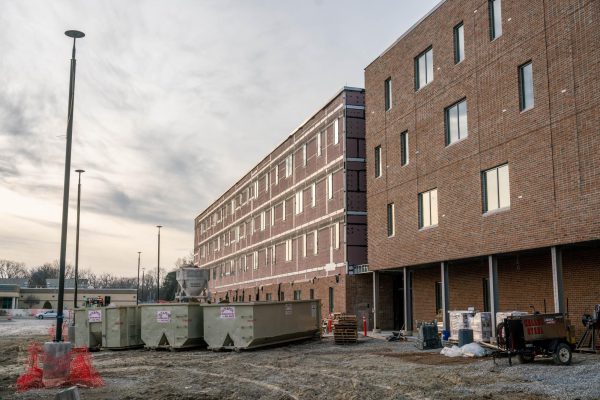AAPR Unveils Draft of Final Recommendations
Oberlin Community members gathered for a public forum in King 306 yesterday to express thoughts and concerns about the AAPR recommendations
On Monday, the steering committee of the Academic and Administrative Program Review released a public draft of its final recommendations that will be submitted to President Carmen Twillie Ambar at the end of this semester. The draft, a 59-page document expanding on the initial areas of recommendation made public in March, was the subject of a well-attended public forum yesterday.
According to Acting Dean of the College of Arts and Sciences and AAPR Chair David Kamitsuka, the draft was informed by feedback gathered from community members over the last several weeks.
“Since the steering committee outlined its ideas in the Summary of Work to Date in mid-March, members have participated in more than 45 meetings with various governing bodies and stakeholder groups,” Kamitsuka wrote in an email to the Review. “The initial presentations and webinar in March alone engaged more than 1,000 faculty, students, staff, alumni, and parents, always with an open exchange of information and ideas as part of the event.”
While much of the latest draft only provides more specific information and directions for the initial areas of recommendation, some new areas are also included.
In particular, this draft provides implementation timelines for each area of recommendation. The timelines begin this summer and stretch, in some cases, through 2024. Additionally, the committee detailed how the areas of recommendation will interact with each other and recommended the formation of an ad hoc committee to track the effectiveness of the recommendations as they are implemented.
While Kamitsuka emphasized the steering committee’s efforts to seek community feedback, some noted that the most recent recommendations are largely the same as they were in March.
“At the end of the day, it felt like the … touching base with everybody was just to explain what AAPR was supposed to do and supposed to be,” said Student Finance Committee Co-Chair and Student Senator Elmo Tumbokon. “And so, if you look at the text body of what the AAPR final recommendations are, not much has changed — it literally is just a more detailed explanation.”
That sentiment was reflected at Thursday’s forum, where the conversation largely focused on the AAPR’s impacts on Oberlin’s hourly employees and bargaining units.
“I don’t think they’re listening to what the people are saying, because they’re not changing anything,” said English Departmental Secretary Linda Pardee, who is also a member of the Oberlin College Office and Professional Employees union. “You know, it’s kind of like they’re letting us listen to what they’re planning on doing. We don’t have a say in it and they’re going to do it, you know, and just suck it up, buttercup.”
Kamitsuka did acknowledge that, given the AAPR’s momentum after a months-long process, its general recommendations are essentially set.
“Until we submit the final report to President Ambar, the steering committee will continue to listen for and consider ideas that will make our recommendations better,” he wrote. “That said, after more than 45 meetings in the last six weeks, the likelihood of major ideas emerging that will substantially change the course of our report naturally grows smaller over time.”
At the forum, Pardee and many other hourly employees expressed concerns over their job security, given data released by the AAPR which says Oberlin pays its hourly employees 34 percent more than comparable institutions, the Five Colleges of Ohio — which include Kenyon College, Denison University, Ohio Wesleyan University, The College of Wooster, and Oberlin College. One of the steering committee’s recommendations with regard to employee compensation is to lower hourly workers’ pay in order to close that gap, as well as reduce the overall number of employees on campus.
When pressed, steering committee members were unable to provide specifics regarding which positions could be cut. Vice President for Finance and Administration Rebecca Vazquez-Skillings noted that such details fell outside of the scope taken on by the AAPR — this response was met largely with skepticism from the crowd.
“For them to sit down and tell us we have to wait another two years to find out if we’re going to have a job, … it’s cruel,” Pardee said.
Ambar also addressed the crowd, challenging community members to think about the connections between institutional sustainability and stable employment opportunities, saying that nobody will be well-off if Oberlin’s structural budget deficits force the College to close its doors.
Despite the forum’s heavy focus on hourly workers, the draft’s final recommendations also outlined the potential roles that other campus offices and committees will play in implementing the AAPR recommendations. The steering committee has taken a collaborative approach to working with the Career Development Center, the Educational Plans and Policies Committee, and the Winter Term Committee.
“Part of the process for developing each recommendation has been a series of conversations and meetings with those most expert in the subject and most closely involved at Oberlin,” he wrote. “Those conversations helped us understand and document what capacity we think will be needed to implement the recommendations, which is detailed at the end of each recommendation, along with costs, infrastructure, timeline, and other elements of implementation.”
In particular, many of the recommendations will fall under the scope of EPPC, which oversees academic departments and tenure-track faculty lines. Associate Dean of the College of Arts and Sciences and EPPC Chair Laura Baudot shared that EPPC is in the midst of considering the recommendations, but has not yet commented publicly on any of them.
The Winter Term Committee, on the other hand, has already unanimously endorsed the AAPR’s recommendations regarding Winter Term programming. It is the first such committee to do so.
Associate Director of the Bonner Center for Service and Learning and Winter Term Committee Chair Tania Boster said that the AAPR recommendations lined up with work already being undertaken by the committee.
“Winter Term had undergone a program review over a year ago — independent of and preceding the AAPR process,” Boster wrote in an email to the Review. “The conclusions contained in that review are very much in line with AAPR’s findings and proposals for enhancing Winter Term. … So, all of us on the committee — students, faculty, and staff — were happy to endorse AAPR’s recommendations and to work on an area of growth that is so widely agreed upon as significant by the campus community.”
Boster shared that the committee will begin implementing changes immediately.
“We are prioritizing efforts to streamline processes for Winter Term 2020, and we’re already working to improve access to resources and clarity of communication around all aspects of Winter Term, from funding to project opportunities,” she wrote. “These are areas of recommendation we’re able and eager to address right away.”
The Career Development Center is also identified as an office that will be key in implementing many of the recommendations. The recommendations acknowledge that the center currently faces significant staffing and funding shortages. However, Associate Dean of Students and Interim Director of the Career Development Center Dana Hamdan is confident that these challenges can be addressed.
“The staff is being built at this time, and the College is searching for a director of the CDC with the vision and energy to implement the AAPR recommendations for career development,” Hamdan wrote in an email to the Review.
Kamitsuka also addressed the proposed ad hoc committee, which would be formed after the conclusion of the AAPR’s work to monitor and ensure the effectiveness of its implementation, and would report directly to the president.
“The recommendation for a follow-up committee to assess progress on implementation and explore further ideas is intended to help weave together the implementation work of governance committees across the institution,” he wrote. “President Ambar has been one [of] the chief advocates for transparency and public communication throughout the AAPR process, an approach very much shared by the steering committee. The result has been a data-driven, transparent process with regular updates, detailed reports, and opportunities for all members of our community to engage. We expect that to continue in this next phase.”
While Thursday’s forum marked the final public forum of the AAPR process, steering committee members emphasized that community members can continue to express feedback and concerns via contact information available on the AAPR website.







